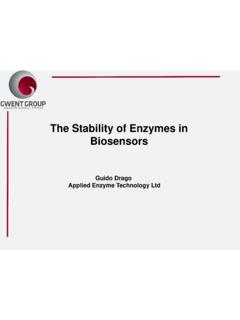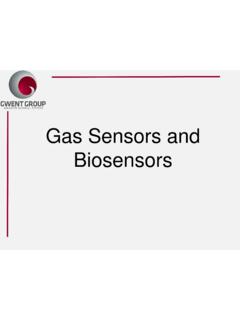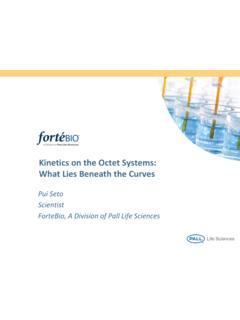Transcription of Introduction to Biosensors - Gwent
1 Introduction to Biosensors Professor Brian Birch LIRANS University of Luton UK. What is a Biosensor? As many definitions as workers in the field! I favour: a device that utilises biological components enzymes to indicate the amount of a biomaterial . Amplification here is useful A biosensor need not provide quantitative information to be of value Pregnancy test is an example: pregnancy is quantised, hence a reading is not useful! The sought material need not be biological . Trace metal ions & ammonia What is a Biosensor? The classical definition Bio recognition Transducer element Signal output Enzymes Electrochemical Antibodies Optical Receptors Whole cells .. What is a Biosensor?
2 The whole picture Sample Bio- Transduction Signal handling recognition interpretation Interference Requires simple read out usually means and data interpretation a need for sample pre-treatment Biosensor Measurement World Biosensor system External External Bio recognition Transduction Data Processing Sample Observer WET DRY. Biosensors Basic Electrochemistry Same Principles/Techniques as In Beaker . Potentiometry Potential Difference at Zero Current Voltammetry Current with Voltage Change Amperometry Current at Constant Voltage Conductimetry 1/Solution Resistance Potentiometry Passive Potential Difference between Two Electrodes Indicator - Biosensor Reference - Invariant Potential with Sample Composition Change Potentiometry uses Nernst Equation E = E0 + RT/nF ln{activity}.
3 Can be used if a biosensor gives a change in pH. with analyte change Not often used Conductimetry Simple measurement Cannot discriminate between different ions Very restricted use in Biosensors Can measure urea with electrode coated with urease NH4. + and HCO - produced 3. Voltammetry Active Technique different species have different oxidation or reduction potentials Usually operates with a potential ramp Species concentration proportional to step or peak Amperometry is a sub technique current at a fixed potential . gives a steady value with time Chronoamperometry current with time Voltammetry 3 electrodes used Working ---- biosensor Counter ---- completes circuit Reference ---- controls potential at biosensor Many operation modes DC ---- not sensitive Pulsed ---- often in conjunction with: Pre accumulation ---- stripping voltammetry A Biosensor Should Be Small, of a size appropriate for use.
4 Not nano size to show how clever you are! Manufacturable in large numbers and at low cost Rapid. Result within the timescale of the process/diagnostic test Economical. Low cost of ownership Always considered as a sensor system with the instrument Self calibrating. Minimal action by user. Probably single use And Most Importantly Satisfy a Strong, Large Market Need!! 1980's ---- Biosensors Would Solve the World's Analytical Needs Industry -- process monitoring and control, particularly food and drink Medicine -- diagnostics, metabolites, hormones Military -- battlefield monitoring of poison gases, nerve agents & people Domestic -- home monitoring of non acute conditions Whatever the application Food quality Water quality In vivo monitoring Blood monitoring Benefits of Biosensors to: Academia -- many new and expanded departments and positions Scientists --10's of 1000's Grants Publications Conferences Users ?
5 Biosensors Commercialised ClearBlue Pregnancy Yes/No Blood Glucose Diabetes Quantitative Colorimetric Test Strip Electrochemical Test Strip Barriers to Commercialisation Economic Blood Glucose and Pregnancy are large markets where users will pay economic prices Technical Biomaterials are fragile Many different materials needed Issues of bonding, connection, reader Blood Glucose Biosensor Electrochemical Confined Volume Two parallel plates Small Gap Electrodes Reagents (GOD, ferricyanide). Blood enters by capillary action Reagents + glucose ferrocyanide Ferrocyanide ferricyanide glucose Blood Glucose Monitors ClearBlue Pregnancy Biosensor ClearBlue - Before a Test 1. Antibody plotted on nitrocellulose 2.
6 Antibody adsorbed 3. latex sprayed onto Assay device wick material stable for months (acts as a reservoir) if kept dry ClearBlue - During a Positive Test Urine sample added Latex resuspended from wick and carried 4. containing hormone 5. in solution into and through the nitrocellulose 6. Urinary hormone 7. binds to antibody adsorbed latex The structure of the nitrocellulose helps the mixing of the latex in the solution ClearBlue - A Positive Test Formation of blue line due to hormone 8. The antibody plotted at the line captures the hormone-latex ClearBlue - During a Negative Test Urine sample added Latex resuspended from wick and carried 4. (no hormone present) 5. in solution into and through the nitrocellulose 6.
7 No hormone present so latex remains unaltered ClearBlue - A Negative Test A blue line does not appear Latex passes past the plotted antibody line 7. as there is no hormone present to form a 'bridge'. Yellow Springs Instruments Glucose and lactate analyzer Electrochemical detection Result in 1 minute High precision Small sample volume (25 l). Low cost per test but instrument investment needed Centralised hospital lab / Research Biacore Direct monitoring of bio molecular interactions No need to use labelled reagents Detection based on Surface Plasmon Resonance Flow system Expensive Research / Drug discovery / Food analysis Cholesterol monitoring 1) Low incentive to use (effects are long term).
8 2) Cost high 3) What do you do with the information? 4) Learnt nothing from the Glucose industries development. Trends over the past 4 decades Biosensor Integration Miniaturisation Specific Sensor systems Making integrated Robust Integration of systems smaller Cheap several steps Mass production Portable Multiple analytes Cheaper components Simple Expensive Easy to use Lab environment Trained users Conclusions Inputs are required from: Biology, Chemistry, Material Science, Electronics & Physics This multidisciplinary process has accelerated during the past 5. years Biomaterial stability has become a reality The large scale manufacture of repeatable sensors for a range of analytes is now almost feasible More must still be done to realise the potential of Biosensors (will be market led).










